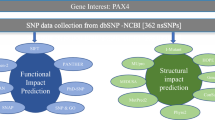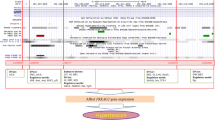Abstract
We have determined the non-synonymous single-nucleotide polymorphisms (nsSNPs) of α adducin 1 (ADD1) gene and its variations in different populations to understand its role in hypertension. Out of 1,113 SNPs, 9 are found to be non-synonymous, of which 7 showed significant damaging effect and one of them showed SNP variability with large differences among the minor allele frequency observed in various populations. The amino acid change found for rs4961 is from glycine to tryptophan, i.e., from an alkyl amino acid to an aromatic amino acid. This residual change is observed in the coiled region of the protein and is also predicted to be disordered by computational algorithm. Protein disorder plays an important role in structural and functional genomics. Hence, because of the complete change in side chains of the amino acid residues occurring in the coiled and disordered region of the protein, the structure of the protein might be altered and the function might be affected, leading to the risk for hypertension.

Similar content being viewed by others
References
Hong, K. W., Jin, H. S., Lim, J. E., et al. (2010). Non-synonymous single-nucleotide polymorphisms associated with blood pressure and hypertension. Journal of Human Hypertension, 24, 763–774.
Oparil, S., Zaman, A. M., & Calhoun, D. A. (2003). Pathogenesis of hypertension. Annals of Internal Medicine, 139, 761–776.
Parmentier, J. H., Pavicevic, Z., & Malik, K. U. (2006). ANG II stimulates phospholipase D through PKCζ activation in VSMC: Implications in adhesion, spreading, and hypertrophy. American Journal of Physiology Heart and Circulatory Physiology, 290, 46–54.
Liu, Y., Zhuoma, C., Shan, G., et al. (2002). A1166C polymorphism of the angiotensin ii type 1 receptor gene and essential hypertension in Han, Tibetan and Yi populations. Hypertension Research, 25, 515–521.
Andresen, B. T., Jackson, E. K., & Romero, G. G. (2001). Angiotensin II signaling to phospholipase D in renal microvascular smooth muscle cells in SHR. Hypertension, 37, 635–639.
Kundu, A., Ramakrishnan, P., Rajendran, A. et al. (2011). Analysis of non-synonymous single-nucleotide polymorphisms and population variability of PLD2 gene associated with hypertension. International Journal of Bioinformatics Research and Applications (in press).
Manunta, P., Burnier, M., Amico, M. D., et al. (1999). Adducin polymorphism affects renal proximal tubule reabsorption in hypertension. Hypertension, 33, 694–697.
Clifford, R. J., Edmonson, M. N., Titia, C. N., et al. (2004). Bioinformatics tools for single nucleotide polymorphism discovery and analysis. Annals of the New York Academy of Sciences, 20, 101–109.
Staessena, J. A., Wanga, J. G., Brand, E., et al. (2001). Effects of three candidate genes on prevalence and incidence of hypertension in a Caucasian population. Journal of Hypertension, 19, 1349–1358.
Cusi, D., Barlassina, C., Azzani, T., et al. (1997). Polymorphisms of alpha-adducin and salt sensitivity in patients with essential hypertentions. Lancet, 349, 1353–1357.
Hughes, C. A., & Bennett, V. (1995). Adducin: A physical model with implications for function in assembly of spectrin–actin complexes. Journal of Biological Chemistry, 270, 18990–18996.
Matsuoka, Y., Hughes, C. A., & Bennett, V. (1996). Definition of the calmodulin-binding domain and sites of phosphorylation by protein kinases A and C. Journal of Biological Chemistry, 271, 25157–25166.
Kuhlman, P. A., Hughes, C. A., Bennet, V., et al. (1996). A new function for adducin: calcium/calmodulin-regulated capping of the barbed ends of actin filaments. Journal of Biological Chemistry, 271, 7986–7991.
Cantiello, H. F. (1995). Role of the actin cytoskeleton on epithelial sodium channel regulation. Kidney International, 48, 970–984.
Berdiev, B. K., Prat, A. G., Cantiello, H. F., et al. (1996). Regulation of epithelial sodium channels by short actin filaments. Journal of Biological Chemistry, 271, 17704–17710.
Wu, M. S., Bens, M., Cluzeaud, F., et al. (1994). Role of F-actin in the activation of Na1-N(1)-Cl cotransport by forskolin and vasopressin in mouse kidney cultured thick ascending limb cells. Journal of Membrane Biology, 142, 323–336.
Wheeler, D. L., Barrett, T., Benson, D. A., et al. (2008). Database resources of the National Center for Biotechnology Information. Nucleic Acids Research, 36, 13–21.
Lee, P. H., & Shatkay, H. (2009). An integrative scoring system for ranking SNPs by their potential deleterious effects. Bioinformatics, 25, 1048–1055.
Hubbard, T. J. P., Aken, B. L., Ayling, S., et al. (2009). Ensembl. Nucleic Acids Research, 37, 690–697.
Ng, P., & Henikoff, S. (2001). Predicting deleterious amino acid substitutions. Genome Research, 11, 863–874.
Zhu, Y., Hoffman, A., Wu, X., et al. (2008). Correlating observed odds ratios from lung cancer case–control studies to SNP functional scores predicted by bioinformatic tools. Mutation Research, 639, 80–88.
Reumers, J., Maurer-Stroh, S., Schymkowitz, J., et al. (2006). SNPeffect v2.0: A new step in investigating the molecular phenotypic effects of human non-synonymous SNPs. Bioinformatics, 22, 2183–2185.
Yue, P., Melamud, E., Moult, J., et al. (2006). SNPs3D: Candidate gene and SNP selection for association studies. BMC Bioinformatics, 7, 166–181.
Cartegni, L., Wang, J., Zhu, Z., et al. (2003). ESEfinder: A web resource to identify exonic splicing enhancers. Nucleic Acids Research, 31, 3568–3571.
Fairbrother, W. G., Yeo, G. W., Yeh, R., et al. (2004). RESCUE-ESE identifies candidate exonic splicing enhancers in vertebrate exons. Nucleic Acids Research, 32, 187–190.
Fairbrother, W. G., Yeh, R. F., Sharp, P. A., et al. (2002). Predictive identification of exonic splicing enhancers in human genes. Science, 297, 1007–1013.
Zhang, X. H. F., Kangsamaksin, T., Chao, M. S. P., et al. (2005). Exon inclusion is dependent on predictable exonic splicing enhancers. Molecular and Cellular Biology, 25, 7323–7332.
Kuhn, R., Karolchik, D., Zweig, A. S., et al. (2007). The UCSC genome browser database: Update 2007. Nucleic Acids Research, 35, 668–673.
Amigo, J., Salas, A., Phillips, C., et al. (2008). SPSmart: Adapting population based SNP genotype databases for fast and comprehensive web access. BMC Bioinformatics, 9, 428–433.
Fisher, A., & Sali, A. (2003). Modeller: Generation and refinement of homology-based protein structure models. Methods in Enzymology, 374, 461–491.
Linding, R., Jensen, L. J., Diella, F., et al. (2003). Protein disorder prediction: Implications for structural proteomics. Structure, 11, 1453–1459.
Shen, J., Deininger, P. L., & Zhao, H. (2006). Applications of computational algorithm tools to identify functional SNPs in cytokine genes. Cytokine, 35, 62–66.
Smith, P. J., Zhang, C., Wang, J., et al. (2006). An increased specificity score matrix for the prediction of SF2/ASF-specific exonic splicing enhancers. Human Molecular Genetics, 15, 2490–2508.
Karchin, R., Diekhans, M., Kelly, L., et al. (2005). LS-SNP: Large-scale annotation of coding non-synonymous SNPs based on multiple information sources. Bioinformatics, 21, 2814–2820.
Reynolds, C. A., Hong, M. G., Eriksson, U. K., et al. (2009). A survey of ABCA1 sequence variation confirms association with dementia. Human Mutation, 30, 1348–1354.
Wang, Z., Wang, J., Chong, S. S., et al. (2009). Mining potential functionally significant polymorphisms at the ATP-binding-cassette transporter genes. Current Pharmacogenomics and Personalized Medicine, 7, 40–58.
Tsunoda, T., Lathrop, G. M., Sekine, A., et al. (2004). Variation of gene-based SNPs and linkage disequilibrium patterns in the human genome. Human Molecular Genetics, 13, 1623–1632.
Scheeff, E. D., & Fink, J. L. (2003). Structural bioinformatics. In P. E. Bourne & H. Weissig (Eds.), Fundamentals of protein structure (pp. 15–39). Hoboken, NJ: Wiley.
Linding, R., Letunic, I., Gibson, T. J., & Bork, P. (2005). Computational analysis of modular protein architectures. In G. Cesareni, M. Gimona, & M. Sudol (Eds.), Modular protein domains (pp. 439–476). Weinheim: Wiley–VCH.
Wright, P. E., & Dyson, H. J. (2009). Linking folding and binding. Current Opinion in Structural Biology, 19, 31–38.
Cross, D. S., Ivacic, L. C., Stefanski, E. L., et al. (2010). Population based allele frequencies of disease associated polymorphisms in the personalized medicine research project. BMC Genetics, 11, 51–66.
Liu, Y., Zhuoma, C., Shan, G., et al. (2002). A1166C polymorphism of the angiotensin II type 1 receptor gene and essential hypertension in Han, Tibetan and Yi populations. Hypertension Research, 25, 515–521.
Katsua, T., Ishikawa, K., Sugimoto, K., et al. (2003). Salt sensitivity of Japanese from the viewpoint of gene polymorphism. Hypertension Research, 26, 521–525.
Yue, P., Li, Z., & Moult, J. (2005). Loss of protein structure stability as a major causative factor in monogenic disease. Journal of Molecular Biology, 353, 459–473.
Bianchi, G., & Cusi, D. (2000). Association and linkage analysis of á-adducin polymorphism: Is the glass half full or half empty? American Journal of Hypertension, 13, 739–743.
Barlassina, C., Schork, N. J., Manuta, P., et al. (2000). Synergistic effect of α-adducin and ACE genes causes blood hypertension and three candidate genes. Kidney International, 57, 1083–1090.
Acknowledgments
Dr. Anand Anbarasu gratefully acknowledges the Indian Council of Medical Research (ICMR), Government of India Agency for the research grant. The authors would like to thank the management of VIT for providing us the necessary infrastructure for conducting this project.
Author information
Authors and Affiliations
Corresponding author
Rights and permissions
About this article
Cite this article
Kundu, A., Anand, A. Computational Study of ADD1 Gene Polymorphism Associated with Hypertension. Cell Biochem Biophys 65, 13–19 (2013). https://doi.org/10.1007/s12013-012-9398-2
Published:
Issue Date:
DOI: https://doi.org/10.1007/s12013-012-9398-2




